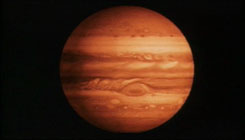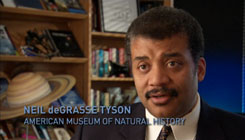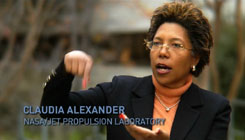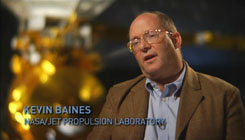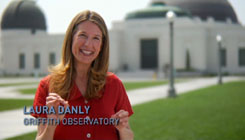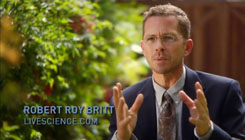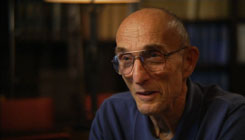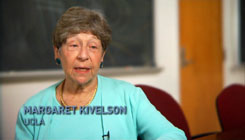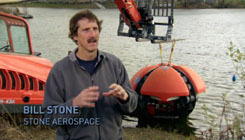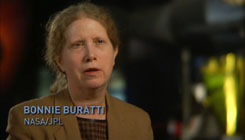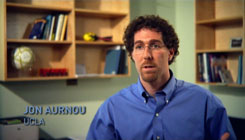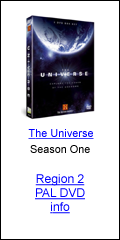This episode proves to be a fairly solid and satisfying
exploration of the planet Jupiter, getting many of the basics across
while also bringing out some of Jupiter's more interesting and obscure properties.
The composition of the planet itself is the first order of business.
As a gas giant with no solid surface, Laura Danly has a good laugh at the
notion that we would be able to ever "land" on it. Instead we focus on its
main features - weather patterns producing jet streams, towering clouds,
and the Great Red Spot, among other storms of varying colours.
Claudia Alexander's analogy of Jupiter's gravity acting as a frisbee thrower
isn't really done justice by the editing of the supporting interviews, narration,
and footage. I had to re-think it and re-visualize it in my head to make sense
of how that would work. Alexander gives a good, solid interview,
but will have an even more interesting nugget to relay to us when she reports the
findings of a probe that descends into Jupiter in
"How the Universe Works: Planets"
Covered briefly but respectably, the first major observations of
Jupiter by Galileo in 1610 are recounted. This leads to a brief introductory
mention of the moons Io, Ganymede, and Callisto. One characteristic feature
of each is plugged before moving on.
The moon Europa takes up a good chunk of screen time, because it is
believed that an ocean of liquid water likely exists beneath its icy frozen crust.
This discovery documented live in Carl Sagan's "Cosmos" episode
"Travellers' Tales" went on to become further popularized
by Arthur C. Clarke's sequel "2010: Odyssey Two", as scientists and regular folk alike
develop a burning desire to know what forms of life may inhabit the region.
To answer this question, we check in with Bill Stone of Stone Aerospace,
whose team is building a robotic explorer capable of navigating through a drilled
hole in the ice to explore the ocean and dynamically follow a pre-programmed scientific
data collection mission to find out.
Finally, we look at Jupiter's largest, but least visible, feature:
its planetary magnetic field.
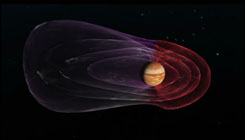 Andy Ingersoll:
Andy Ingersoll:
"The magnetosphere of Jupiter is
the biggest object in the solar system.
It's a lot bigger than the sun."
Hats off to the production team for making this section remarkably
majestic and sublime, a markedly different tone than the show is usually
known for. Actual radio emissions from this field are mixed into the
soundtrack along with some grand, soothing music, while recreations
of the auroras at Jupiter's poles waltz past on screen. Added to the
interviews of Andy Ingersoll and Margaret Kivelson, as they describe
these properties that first attracted them to the study of Jupiter,
one gets the sense of a lasting romance with the planet.
Sagan's Cosmos can eat its heart out!
Chapter Breakdown:
- Introduction
- A Churning Ball of Gas
- The Red Spot
- Secrets of Europa
- The Magnetic Field
- Listening to Jupiter
|
Participants include:
|

